Life can feel overwhelming, and it’s easy to feel powerless when stress hits hard. Many people now turn to practices like black magic as a way to take back control. This guide will show you safe, practical methods and tools that honor both your ethics and personal limits.
Get ready to explore a practice that might just change your perspective.
Key Takeaways
Black magic utilizes ancient tools like talismans, sigils, and grimoires such as the Malleus Maleficarum and the Lesser Key of Solomon. Modern practitioners often use these alongside new technologies to document their rituals.
Popular culture often misrepresents black magic, portraying it as purely evil. This misconception often lumps practices like Vodou into the same category, though Vodou is a religion focused on healing, not malicious spellwork.
Safe practice is grounded in clear intentions and a deep respect for free will. Many witches follow the law of return (or threefold law), a principle stating that the energy you send out returns threefold, making harmful curses and hexes an unwise choice.
Modern spellwork often involves creating chalk circles for protection and using colored candles for specific intentions. Black candles are used to banish negativity, while red can invoke passion and green can attract prosperity.
Interest in black magic is growing globally, especially in cities like Bangkok, where it trends on apps like TikTok. Research from organizations like the Pew Research Center shows that belief in witchcraft is widespread, with over 40% of people in 95 surveyed countries believing in it.
Table of Contents
Understanding How to Use Black Magic

Black magic draws from ancient arts, connecting with supernatural forces to enact change. People often assume it is purely evil, but knowledge gives you the power to choose wisely and act ethically.
What is black magic and what is its purpose?
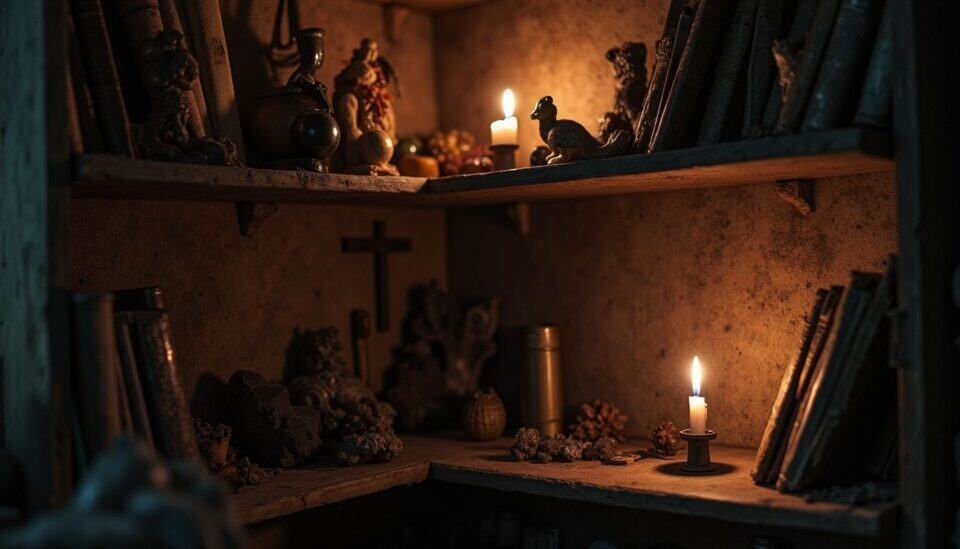
Black magic, sometimes called “nigromancy” in historical texts, involves tapping into supernatural forces to influence events or people. Its purpose is defined entirely by the practitioner’s intent.
The term can be traced back to Edmund Spenser’s epic poem “The Faerie Queene.” Historically, dark rituals, like the Black Mass allegedly performed by Étienne Guibourg in 17th-century France, were often aimed at cursing enemies or gaining selfish power. These events cemented its negative reputation.
However, what separates it from other practices is the user’s goal. Many modern practitioners focus on self-empowerment, protection, or correcting injustices, rather than causing harm.
Those who practice it use tools like talismans, sigils, and influential grimoires like the Malleus Maleficarum and A.E. Waite’s The Book of Ceremonial Magic. While historical witch trials led to many executions, today’s Wiccans and most modern witches avoid manipulative practices. They instead focus on seeking wisdom or good fortune.
What are common myths and misconceptions about black magic?

Now that you know what black magic is, let’s clear up some common myths. Many people believe all of its practitioners are connected to evil or Satanic pacts, an idea fueled by historical figures like Catherine Monvoisin and sensationalized by Hollywood.
Movies rarely show that “black” and “white” spellwork exist on a spectrum. Most magic falls into a gray area, where intent matters more than labels.
People also wrongly categorize the religion of Vodou as black magic. In reality, Vodou focuses primarily on healing and spiritual connection, a far cry from the dark rituals described in books like The Lesser Keys of Solomon.
Witch hunts were fueled by fear and flimsy evidence. Today, it’s clear that most magical acts are for self-protection, blocking negative energy, or pushing back against systemic unfairness.
Another myth is that every ritual is meant to cause harm. But tools like talismans and sigils are usually created to improve one’s life. Thinkers from Heinrich Cornelius Agrippa to modern practitioners have shaped these traditions with a focus on personal growth.
Want to know how white versus black magic really compare? That link gives you facts instead of the scary stories you see on TV.
Tools and Materials for Black Magic
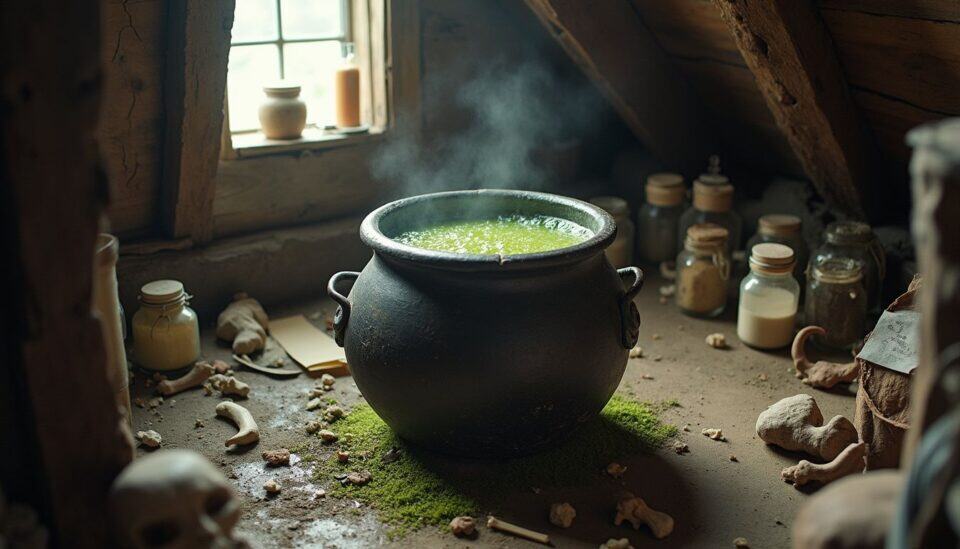
Ancient tools for black magic appear in many cultures, holding symbolic power that helps focus your intention. Using the right tools makes your practice more effective.
What ritual items are commonly used in black magic?

Powerful ritual items are the foundation of any black magic work. These tools, both old and new, help shape spells and create protected spaces.
- Amulets provide spiritual armor against negative forces. These can be worn jewelry or protective symbols like the Hamsa Hand placed in your home.
- An athame is a ritual dagger, often double-edged with a black handle, used to direct energy and cast circles. It is a tool for channeling willpower, not for physical cutting.
- A besom, or broom, is used for ritually cleansing a space of old energies before you begin a spell.
- A cauldron can be used to safely burn herbs and incense or for scrying when filled with water. A small cast-iron pot works perfectly.
- Potions mix herbs and liquids for specific goals, such as protection oils made with rosemary or banishing sprays made with black salt.
- Magic circles create safe, contained spaces for rituals to take place. They are often drawn with chalk or salt.
- A wand, traditionally made from trees like rowan or ash, helps direct energy with focused movements. Your own finger can also serve this purpose.
- Talismans carry sigils or symbols designed to attract specific energies or block curses.
- A pentacle is often a flat disc inscribed with a five-pointed star or other magical symbols. It is used on an altar to represent the element of Earth and for consecrating other tools.
- Candles are essential. White candles are used for cleansing and protection, while black candles are excellent for banishing negativity or absorbing harmful energy.
Each item has a deep history within mystical traditions. Magic thrives when you trust your intuition and use the tools that feel right for you.
How are talismans and sigils used in black magic?

Sigils work a bit differently. You create them yourself by drawing a unique symbol that represents a specific goal or desire.
Once, I drew a sigil for confidence on a small piece of paper before a stressful job interview. I used my favorite black pen, folded the paper, and kept it in my pocket all day. It felt like a secret source of strength.
Rituals often involve drawing protective circles or pentagrams to set up your energetic workspace. These tools work best when you maintain a clear and focused intention throughout the entire process.
“The energy you put into crafting a talisman will echo in every outcome.”
What ancient texts and languages are important for black magic?
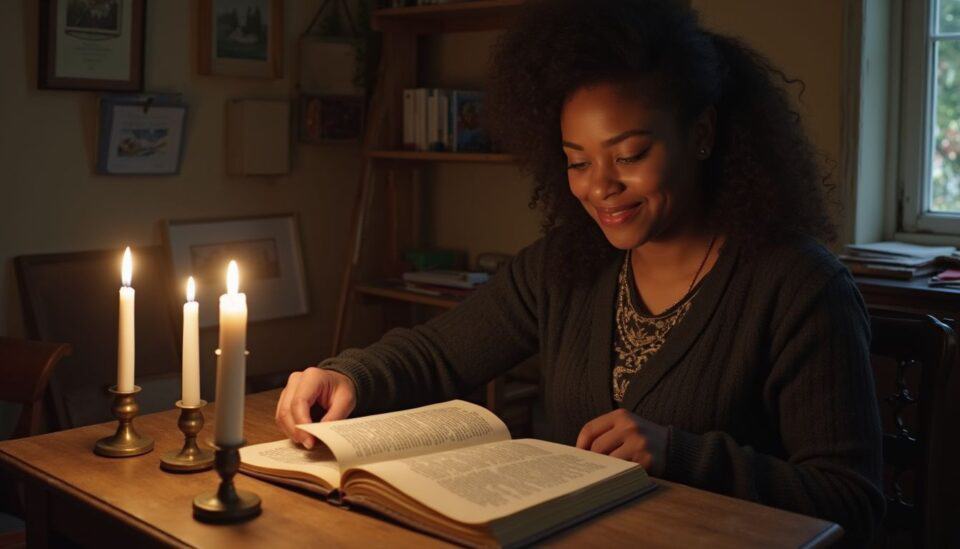
One important historical text is the Tree of Knowledge (Ets ha-Daat) by Elisha ben Gad of sixteenth-century Italy. This book contains around 125 different rituals rooted in Kabbalistic traditions and is primarily written in Hebrew.
Latin is another key language in Western magical traditions. The infamous Malleus Maleficarum (“The Hammer of Witches”) from the 15th century details methods for identifying witches, though it’s now seen as a historical document of persecution rather than a practical guide.
Another foundational work is The Key of Solomon, a grimoire that contains invocations, spells, and sigils. Many practitioners find it useful to learn some basic Latin or Hebrew to better understand the origins and intent behind historical spells and rituals.
Many modern witches and magic workers still draw inspiration from these ancient books for protection rituals and setting intentions today.
Basic Principles of Using Black Magic

Every spell begins with a clear goal and careful focus. Directing your personal energy is the most important part of any magical working.
How do you set intentions for black magic rituals?

Start by taking a deep breath and focusing on what you truly want. Picture your goal with as much detail as possible, and write down your intention using simple, direct language.
Lighting a candle or drawing a sigil can help lock in your desire. It gives your energy a physical anchor to connect with.
A wise teacher once told me, “Clarity in magic is as vital as a clear lens on a camera.” It’s crucial to always respect free will. Never use magic to force someone to act against their own choices, as this is a key principle for safe and ethical practice.
I once tried a ritual without a clear intention, and my energy felt scattered and ineffective. Choose words, images, or symbols that resonate deeply with your purpose. Charge them with focused energy before you begin.
What are effective ways to channel energy in black magic?

Once you have a clear intention, you can direct energy toward it. Many practitioners find that holding a talisman or tracing a sigil helps their energy flow more smoothly into a spell.
Visualization is another powerful technique. Clearly see your goal in your mind’s eye as if it has already happened.
Some people find that certain music or rhythmic drumming helps raise energy. Others use physical objects like a wand or athame to direct their focus outward.
Ultimately, your personal focus shapes the results. Your belief is the fuel that powers every step of your magical work.
What is the law of return and how does it affect black magic?
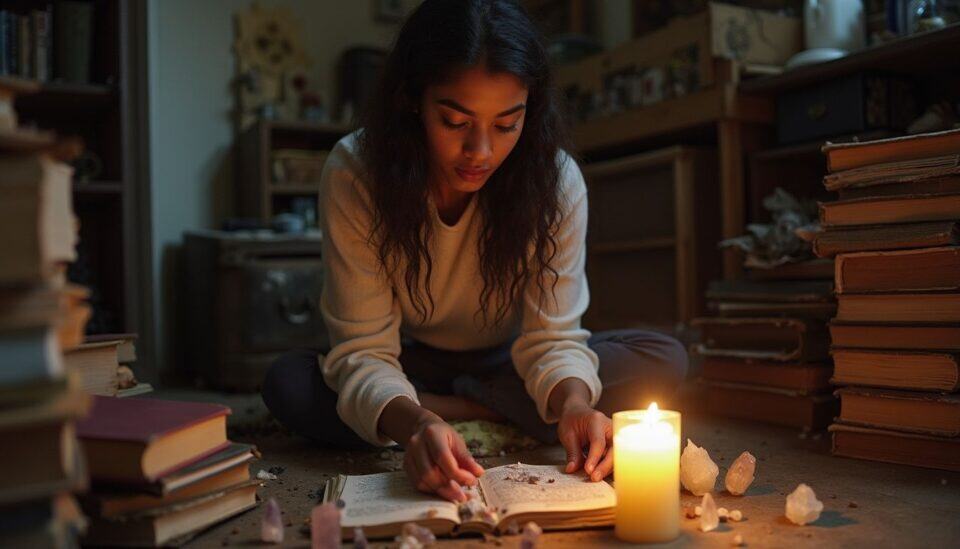
The law of return, often called the threefold law in Wiccan traditions, suggests that any energy you send out comes back to you three times stronger. This applies whether the intent is helpful or harmful.
The concept was popularized by Gerald Gardner, a key figure in modern Wicca, and later by authors like Raymond Buckland. It serves as a strong ethical guideline.
This “law” acts as both a shield and a warning. It discourages practitioners from casting malicious spells like curses or hexes, as the negative consequences could rebound with triple the force.
The law of return reminds magic users that every ritual has consequences. Smart spellwork begins with understanding this principle. Now, let’s explore how black magic rituals work with these ideas in mind.
Common Practices in Black Magic

Let’s look at how to cast spells, create protective wards, and work with ancient texts through magic and witchcraft.
How do you cast spells in black magic?
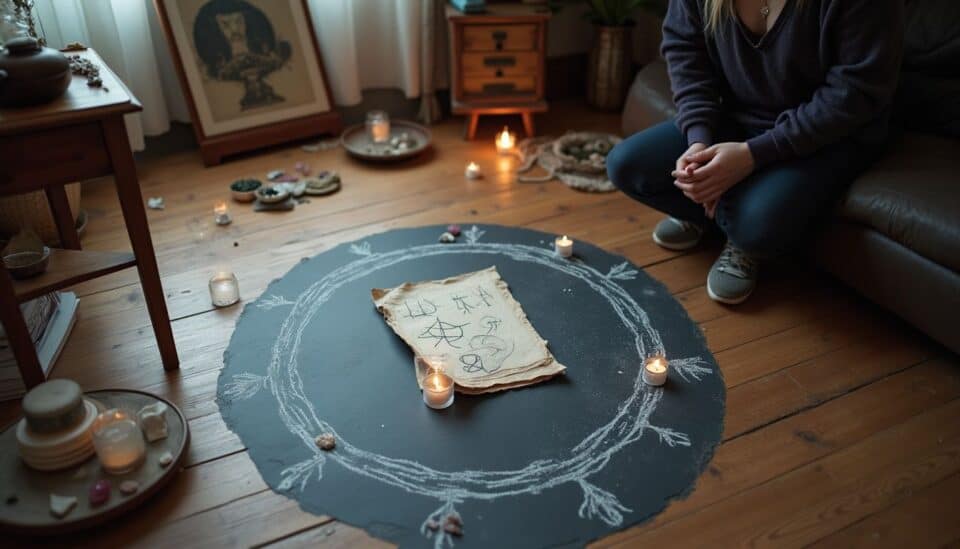
Casting black magic spells requires ritual, intention, and focus. Many find this practice to be practical and empowering.
- First, gather your ritual tools. You will need items like candles, incense, chalk, and a journal or “Book of Shadows” to write down your spells and track their results.
- Set up your workspace with care. This might involve drawing a circle on the floor or creating an altar with crystals, herbs, or a photo of your target.
- Focus your energy by visualizing your goal while speaking your intention aloud. You can use English or older languages like Latin.
- Use talismans and sigils that you have created yourself. I often draw mine on parchment while whispering my goal.
- Personal items, like hair or jewelry, can serve as powerful links to connect your spell to its target.
- Burning a piece of paper with a written name or sigil is a common practice. The smoke is believed to carry your intention into the universe.
- Write every detail of your ritual in your journal. Recording your steps helps you improve your skills and notice patterns over time.
- Channel your energy by gazing at a candle flame while holding a crystal. Picture power flowing from you into the object.
- Always ground yourself after a ritual. Touching the earth or holding a grounding stone like hematite helps release excess energy safely.
- Remember the law of return. Most practitioners believe the force you send out returns threefold.
- Always honor free will. Attempting to force someone against their will can create negative backlash.
- If you feel unsure about a step, research it in trusted books or seek advice from experienced practitioners.
Success in spellcasting depends as much on your self-confidence as it does on your tools.
I have burned many sigils late at night after feeling worn down by daily pressures. Sometimes I work alone, and sometimes with friends. I always record each result to learn what works best for me.
What are the steps to perform black magic rituals?
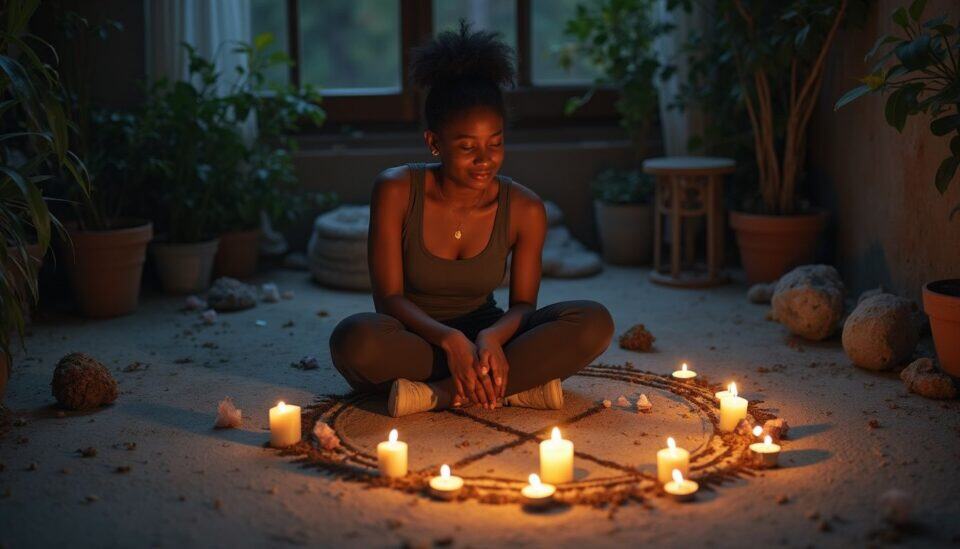
These clear steps for performing a black magic ritual are based on personal experience and common traditions.
- Draw a sacred circle or pentagram on the ground with chalk or salt to define your ritual space.
- Place your ritual items, such as candles, incense, and herbs, inside the circle.
- Adjust the lighting to create a focused atmosphere. Many prefer the soft glow of candles.
- State your intention clearly and confidently. Make sure you can hear your own voice echo in the space.
- Write your target’s name or your goal on parchment, or carve a sigil into a candle.
- Arrange your tools in a way that feels meaningful to you. Some traditions align tools with cardinal directions, like placing the wand to the south for Fire.
- Light your candles. A black candle can absorb unwanted energy, while a white one brings spiritual clarity.
- Focus your mind inward, concentrating all your energy within the circle. Your hands might tingle, or the air may feel heavier.
- Speak to spirits only if you know their true names and have taken protective measures. Respect is key.
- To close the ritual, thank any entities you may have called upon. Extinguish the candles and cleanse the circle, often by sweeping with a besom or wiping away chalk lines.
If anything feels wrong or unsafe, stop immediately. For help clearing negative energy, you can learn more about removing black magic safely.
How can you create protective wards using black magic?
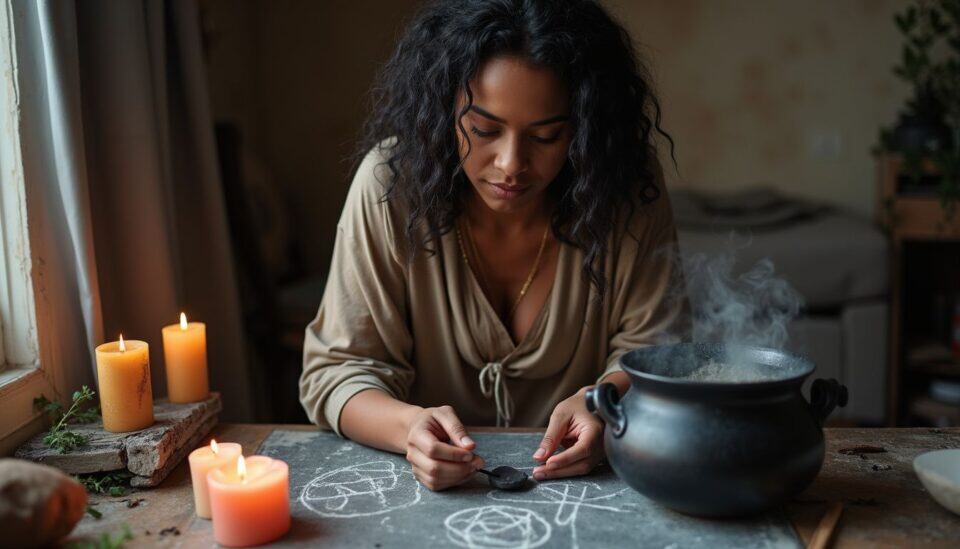
Protective wards are energetic shields that block negative energy and harm. Here are some common and effective methods for creating them.
- Draw a circle with chalk or sprinkle black salt at your doorways and windowsills to create a protective barrier. Black salt can be made by mixing sea salt with ashes from protective herbs like sage, or even scrapings from a cast iron cauldron.
- Place protective amulets, such as iron keys or crystals like black tourmaline, near entrances to act as spiritual alarm systems.
- Light candles in specific colors. Black banishes harm, white brings peace, and red boosts courage.
- Carry protective stones like obsidian or hematite with you. These stones are known for absorbing negative vibrations.
- Draw protective sigils with ink near your bed or on the inside of your front door to act as silent guardians.
- Chant protective spells from trusted sources. Speaking the words aloud can amplify a ward’s power.
- Burn herbs like rosemary, sage, or mugwort and walk clockwise around your space. The smoke from these herbs cleanses the area of negative spirits.
- Call on protective deities or spirits, like Hecate or Archangel Michael, with respectful words and offerings.
- Keep protective herbs under your pillow. Bay leaves are said to prevent nightmares, while lavender brings calm sleep.
- Strengthen your wards with visualization. Before sleep, picture a shield of golden light forming an impenetrable wall around you and your home.
For more about staying safe, read this advice on preventing black magic harm.
Ethical Considerations in Black Magic

Using sigils, incense, and ancient words helps shape a ritual’s intent. Respecting personal choice is the core of a safe and ethical magical practice.
Why is respecting free will important in black magic?
Casting spells intended to control someone can cause serious problems. A core ethical principle in many modern witchcraft traditions is the Wiccan Rede: “An it harm none, do what ye will.” This advises practitioners to act freely, as long as their actions cause no harm to others.
A friend once cast a love spell on someone she had a crush on. The spell seemed to work, but the relationship that followed was filled with jealousy and unhappiness, eventually falling apart and causing pain to both of them.
Ignoring free will can lead to karmic backlash. The law of return suggests that manipulative energy will come back to you, often magnified. Experienced practitioners use their tools to protect and empower, not to control.
Honoring free will keeps both your power and your conscience clear. Ethical practice means pausing before any ritual to consider its full impact on everyone involved.
What harmful practices should be avoided in black magic?
Rituals that call for curses, hexes, or summoning unknown entities can backfire badly. Actions meant to harm someone’s physical, mental, or spiritual well-being put everyone involved at risk.
I once watched a friend’s revenge spell spiral out of control. Not only did it fail to affect the target, but my friend experienced a string of bad luck and sleepless nights. Even whispering harmful intent over a talisman can attract negative energy.
Social backlash is also a real concern. Practices that ignore the law of return should be avoided. The witch hunts of the 1600s are a stark reminder of how fear and accusations of harmful magic can destroy lives.
Using black magic for selfish gain at the expense of others often brings darkness into your own life. Always choose rituals and symbols that prioritize safety, responsibility, and respect.
Advanced Techniques in Black Magic
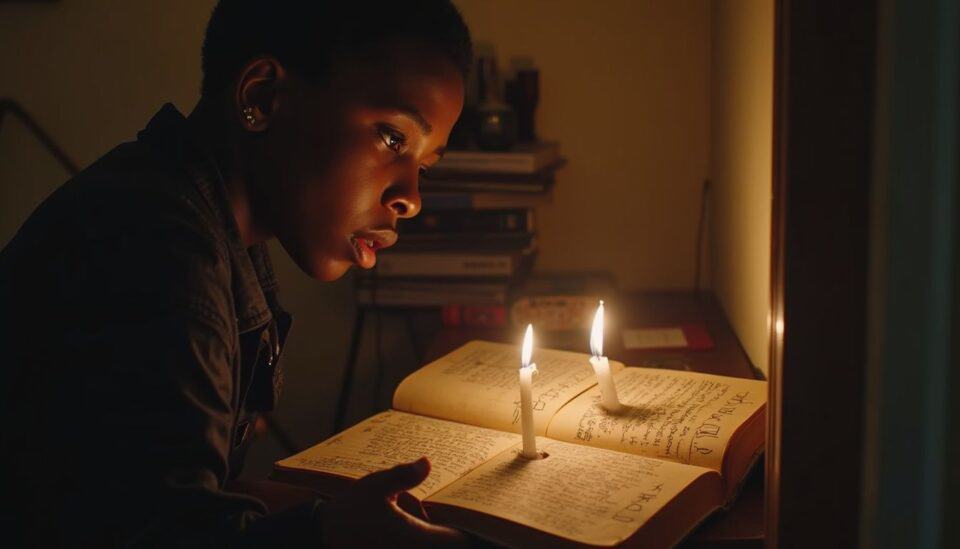
If you’re ready to explore deeper spells or work with ancient grimoires, these advanced techniques can push your skills further. Always proceed with caution and thorough preparation.
How do you summon spirits in black magic?
Summoning spirits is a practice that requires careful preparation to avoid spiritual danger. It should never be attempted by beginners.
- Gather your ritual items, including candles, incense, a chalice, and a blessed dagger or athame.
- Draw a sacred circle on the floor. A pentagram is often added for extra protection.
- Study ancient texts like “The Lesser Key of Solomon” for proper instructions and powerful incantations.
- Speaking the spirit’s true name aloud is considered vital for a successful and controlled summoning.
- Recite the specific spells from your chosen text word-for-word while focusing on your intention.
- Place protective talismans at the edge of your circle to create wards against unwanted entities.
- Channel energy through focused breathing or rhythmic drumming.
- Stay alert for signs of presence, such as temperature drops, unexplained noises, or shifting shadows.
- When you are finished, you must formally dismiss the spirit respectfully and thoroughly cleanse your space with salt water or sage smoke. Using tools like a Ouija board is highly discouraged by many practitioners due to the risk of attracting malevolent or deceptive entities.
Spirit summoning is incredibly risky. Handle every step with caution, deep respect, and an understanding of the forces you are dealing with.
What are binding spells and how are they used?
Binding spells aim to create a magical link or restraint. A common ethical use is a “bully binding,” which is designed to stop someone from causing harm to themselves or others.
A simple binding spell might involve writing the person’s name on a piece of paper, wrapping it tightly with black thread while stating your intention, and then safely burning the packet to release the energy. The goal is to neutralize harmful actions, not to punish the person.
Love binding spells are highly controversial because they often violate free will. A more ethical approach is to perform a spell to strengthen an existing, consensual bond, but never to create one against someone’s will.
How do curses and hexes function in black magic?
Curses and hexes are spiritual traps designed to send harmful energy toward a person, place, or object. Historically, people used objects like dolls or carved lead tablets to direct ill will toward an enemy.
The legend of the evil eye is a well-known example of this belief. Many cultures believe that a malicious glare can cause bad luck or illness unless countered with protective charms or talismans.
Casting these spells often brings negative consequences for the magician as well. The law of return suggests this harmful energy will likely find its way back to the sender, but magnified. For this reason, most modern, ethical practitioners strongly advise against ever using curses or hexes.
Tips for Beginners

If you’re new to this, start with the basics. Gather a few simple tools, practice regularly to build confidence, and never be afraid to ask for help when you feel lost.
What are simple spells to start with as a beginner?
Simple spells help you build confidence and often yield clear results. Keep a spell book or journal to track your progress.
- Create a protective circle with salt. Stand inside, close your eyes, and visualize a shield of white light surrounding you. This is a basic way to ward off negative energy.
- Light a white candle and quietly state your intention for the day. You can ask for peace, focus, or a good night’s sleep.
- Carry a small pouch of protective herbs, like rosemary or basil, in your bag for good luck.
- Create a simple protection jar. Fill a small jar with salt, protective herbs like rosemary, and sharp objects like pins or needles to “catch” negative energy, then seal it with wax from a black candle.
- Place three pinches of salt in each corner of your bedroom while asking for safety and peace before you sleep.
- Write a wish on a bay leaf with a pen. Burn the leaf safely in a fireproof container, like a cauldron, and release the ashes to the wind.
- Anoint your doors and windowsills with a protective oil, like one infused with frankincense, to keep your home safe.
- Say, “Only good may enter here,” as you walk through your home with a lit candle.
- Keep daily notes in your personal spell book about what you tried and how it made you feel. This record is one of your most valuable learning tools.
My first experiments involved making simple salt circles before bed. I was surprised by how much calmer and more centered I felt each morning.
How can beginners practice black magic consistently?
Create a regular ritual schedule. Choose one or two days a week to dedicate to your practice, even if it’s just for 15 minutes. Consistency is more important than complexity.
Focus on simple actions, like meditating with a protective crystal or lighting a candle with a clear intention. This helps sharpen your mind and control your energy.
I started by simply burning black salt incense during my evening meditation to calm my nerves. It was a small step, but it made a huge difference in my ability to focus.
Build complexity at your own pace. Start with low-risk spells, like those for self-protection, and only move on to more advanced work when you feel confident. Always respect your personal boundaries so your practice feels safe and empowering.
When and how should you seek guidance from experts?
A consistent routine is helpful, but sometimes you’ll encounter challenges. My first attempt at creating sigils from an old spell book left me completely confused, and seeking guidance saved me from making mistakes.
Getting advice from experienced practitioners or joining a study group can prevent simple errors. Many people find helpful mentorship through online forums, local metaphysical shops, or established covens.
Always seek guidance before attempting advanced practices like summoning spirits. These rituals carry real risks if performed incorrectly. Be critical of information you find online, as misinformation can spread quickly on social media.
How Will Black Magic Change in 2025?

Modern magic is constantly evolving, blending ancient traditions with new technology. Social media platforms, especially TikTok, will likely continue to drive this growth in 2025 and beyond.
In cities like Bangkok, you can already see spellwork tutorials mixing Hindu mantras, Buddhist prayers, and Chinese spirit offerings flooding social media. Research from institutions like Chulalongkorn University has shown that interest in magic often increases during times of economic hardship or social unrest.
Online forums and group chats will continue to be important spaces for people to explore rituals safely. They can share resources, from handmade sigils to translated ancient texts.
As these practices become more mainstream, many will view black magic not as something to fear, but as a valid method for stress relief and personal empowerment. It offers a way to feel in control when the world feels chaotic.
People Also Ask
What is black magic, and can it be used safely?
Black magic refers to spells or rituals intended to influence outcomes. It can be used safely by setting clear intentions, respecting the free will of others, and focusing on protection and empowerment rather than harm.
Are there tools that make black magic safer?
Yes, tools like candles, herbs, and protective crystals help focus your intent and ground your practice in safety. Using salt to cast a protective circle before any ritual is a fundamental safety measure.
How do I know if my actions are ethical when using black magic?
Ask yourself if your actions respect another person’s free will and cause no harm. A key guideline for many is the Wiccan Rede: “An it harm none, do what ye will.” If a spell feels wrong, trust your intuition.
Can beginners try black magic without risk?
Beginners should start with simple rituals focused on self-protection or personal growth. Stick to safe, ethical guidelines and avoid advanced practices like summoning or cursing until you have significant experience and guidance.
References
https://en.wikipedia.org/wiki/Black_magic
http://mcsprogram.org/libweb/u122CH/242159/Learn%20All%20Black%20Magic.pdf
https://science.howstuffworks.com/science-vs-myth/extrasensory-perceptions/black-magic.htm (2024-08-12)
https://www.scribd.com/document/424704975/How-to-Do-Black-Magic
https://blogs.bl.uk/asian-and-african/2020/08/the-tree-of-knowledge.html (2020-08-19)
https://www.researchgate.net/publication/371702077_The_Basic_Remedies_for_Complete_Black_Magic_Problems (2023-06-20)
http://mcsprogram.org/libweb/u28GF4/243103/Black%20Majick%20Spells.pdf
https://ftp.spaceneedle.com/browse/mL96A7/604650/Black%20Magic%20Spells.pdf
https://www.wikihow.com/Do-Black-Magic
https://www.acuam.com/wp-content/pgs/?binding_spells__their_role_in_love_and_relationships.html
